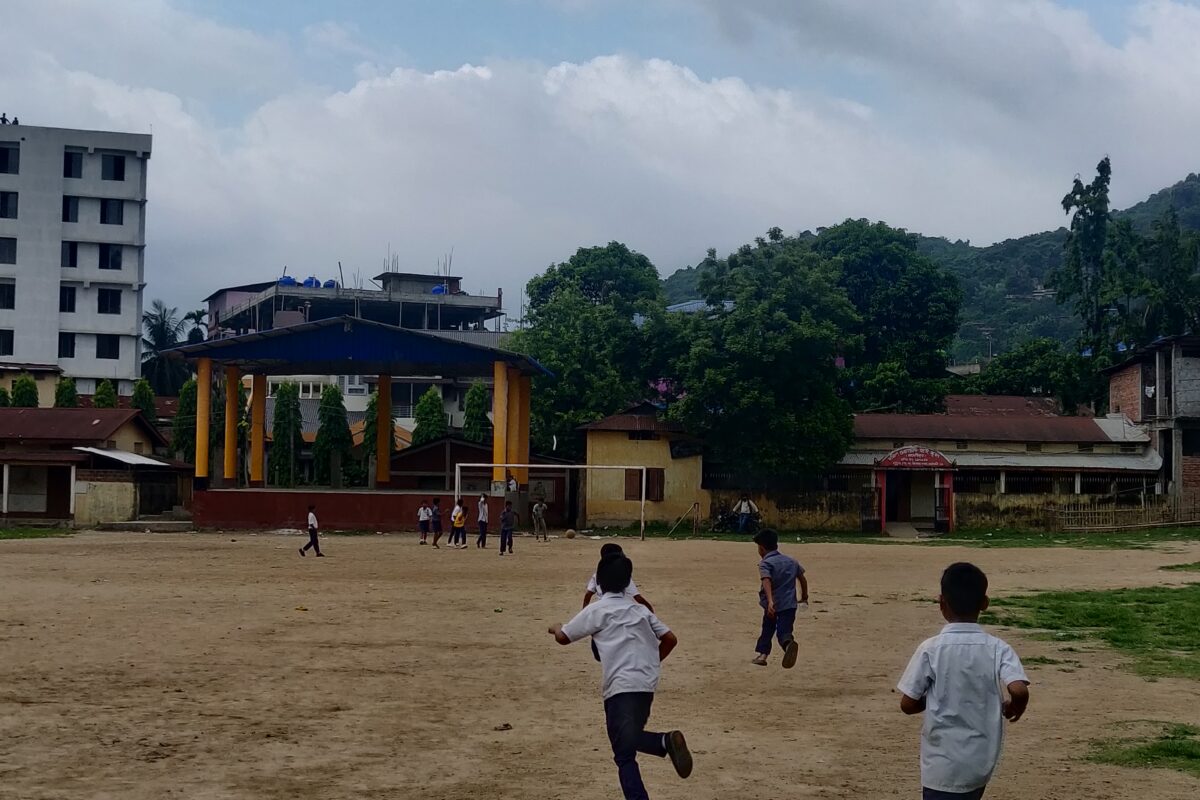Like those preceding it, the year 2024 broke new records in the ever-growing number and scale of extreme climate events around the world. Every month sees a new headline linking heat waves, children’s health, and learning. We decided to group them together here in order to highlight the dual relationship between access to education and socio-environmental issues, underscoring the urgency of both radical ambitious climate action and educational reform.
While heat waves will be the focus of this article, other extreme weather events such as floods also have a major impact on education, as has been recently the case in Vietnam and Thailand (Save the Children, September 2024).

School kids are playing in the playground in India. Source : Mongabay (September 2024).
School Closings and Health Concerns
This article resonates with ongoing and recent world news, portraying schools – in South and East Asia, Africa and to a lesser extent in Southern Europe and North Africa – closing due to heatwaves. For example, in March, in South Sudan, temperatures as high as 41-45°C have led to the closure of all schools, urging parents to monitor children for heat-related illnesses (such as cramps, exhaustion, and strokes). School closures also happened in April, in the Philippines, where extreme heat forced the closure of hundreds of schools, and in May, in parts of India and Pakistan. In Pakistan’s Punjab province, more precisely, more than 26 million children, or 52% of the country’s school-age population, missed over a week of school.
Children’s concentration is also under threat during heat waves. High temperatures often lead to increased absenteeism and reduced concentration among students. Indeed, in 2018, Harvard researchers analysed data from over 10 million children and found that exam scores were lower during warmer years. This was also measured during weekends and holidays. This is also being proven through local research. In Ethiopia, a World Bank study found that exam scores decrease with each day the temperature exceeds 33 degrees Celsius.
These effects increasingly affect countries in more temperate and northern latitudes. Last June, for instance, Greece experienced its earliest-ever heatwave, which forced the closure of public schools and kindergartens. Schools are more and more taking stands on the need for climate resilience in Canadian educational facilities as well.
(Poor) Children are the First Victims of Heatwaves
Socio-ecological catastrophes disproportionately affect the poorest populations, which are also the least responsible and the least equipped to protect themselves. In 2021, through a new climate risk index for children, UNICEF identified that about half of the world’s children (around a billion) was living in one of the 33 countries considered at very high risk to the effects of climate change. Experts believe this high number of affected children can be explained by the fact that the countries most affected by climate change tend to also be the poorest, the most populated and the youngest ones. In April 2024, Save the Children was also demonstrating that half of the world’s out-of-school children and teenagers were residing within these same very high risk countries.
Economic Disparities in Education
The economic toll of climate change on education is profound, especially in poorer regions. Families in economically disadvantaged areas often face severe financial pressure during extreme weather events. In Liberia, for example, climate-induced agricultural challenges have forced parents to withdraw their children from school, as they can no longer afford the fees. This is a familiar story in many parts of the Souths, particularly among rural populations that rely on climate-sensitive livelihoods like farming.
Wealthier schools, on the other hand, are more likely to be equipped with cooling systems and other infrastructure to cope with extreme heat. This deepens the divide between students from affluent families, who can continue learning during heatwaves, and those from poorer backgrounds, who are more vulnerable to school closures and health risks. For instance, in India, only a fraction of public schools are equipped with air conditioning, leaving millions of students exposed to high temperatures.
Gender Disparities in Education
Gender disparities in education also worsen under climate stress. As observed in Indonesia and Nepal in late August, extreme weather events such as droughts and floods have disproportionately disrupted the education of young women and girls.
In many cases, they are the first to be withdrawn from school when families face financial pressure or when extreme weather threatens safety and mobility. The unequal impact on girls is compounded by social norms and economic vulnerabilities that prioritise male education in crisis situations.
Conclusion
As climate-related disruptions to education become increasingly frequent and severe, in particular in vulnerable countries, it is crucial to combine drastic actions against the fossil fuel industry and other major contributors to environmental change, with the promotion of alternative and democratic learning frameworks. As a matter of fact, the most transformative and regenerative pedagogies – that is to say, approaches that are responsive to the interactions and needs of learners and their living environments – can play a pivotal role in fostering awareness and equipping future generations with the knowledge and skills necessary to address socio-ecological issues. Furthermore, these educational frameworks should provide space for young people to discuss the direct and indirect impacts of climate change on their mental health, and reclaim the power to change their lives.




